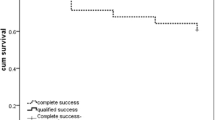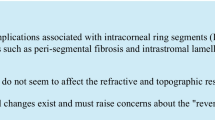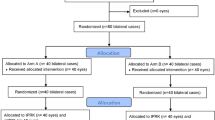Abstract
Subepithelial haze and concomittant refractive regression are the most important complications of photorefractive keratectomies (PRK) in the higher diopter range. Twenty previously photokeratectomized myopic eyes, which showed a certain level of subepithelial scarring, were examined in the present study. The range of PRK treatment varied between — 4.0 and - 12.0 D (on average - 7.4 ± 3.88 D). Subsequent subepithelial haze was graded between 0.5 and 4.0, according to Hanna et al. The first ultrasound biomicroscopy (UBM) was performed between 1 and 3 months following PRK with the 50–80 MHz transducer of a Zeiss-Humphrey Model 840 ultrasound biomicroscope. A control UBM examination was carried out in each patient 3 months after the initial assessment. The severity of subepithelial haze correlated with the previous photo-ablation depth. Below and including Haze Grade 2.0, UBM showed loss of the Bowman’s membrane and a slight thinning of the central 5.5 mm diameter cornea. Above Grade 2.0, the reflectivity of the anterior stromal parts began to increase. Between Grades 3.0 and 4.0, a hyper-reflective one-third of the anterior stroma with irregular borders was observed. In conclusion, haze graded below 2.0 was not observable with UBM. Haze graded more than 2.0 caused increased anterior stromal reflectivity in the central cornea. Ultrasound biomicroscopy was found to be a suitable method for presenting and following data over time for each patient with serious haze phenomena after excimer laser photo-ablation.
Similar content being viewed by others
References
Sciler T, Holschbach A, Derse M, Jean B, Genth U. Complications of myopic photorefractive keratectomy with the excimer laser.Ophthalmology 1994,101:153–60
Fagerholm, Hamberg-Nystrom H, Tengroth B. Wound healing and myopic regression following photorefractive keratectomy.Acta Ophthalmol (Copenh) 1994,72:229–34
Nagy ZZs, Süveges I, Németh J, Füst á. The surgical correction of refractive errors of the eye.Acta Chirurg Hung 1994,34:103–13
Nagy ZZs, Süveges I, Németh J, Füst ↠. Experiences with photorefractive keratectomies.Oruosi Hetilap 1995,136:1035–41
Hanna KD, Pouliquen YM, Waring GO, Savoldelli M, Fantes F, Keith P, Thompson KP. Corneal wound healing in monkeys after repeated excimer laser photorefractive keratectomy.Arch Ophthalmol 1992,110:1286–91
Pavlin J, Förster B.Ultrabiomicroscopy of the Eyes. Berlin: Springer Verlag, 1995
Naumann GOH, Sautter H. VII. Surgical procedures on the cornea. In: Blodi FC, Mackensen G, Neubaues H (eds)Surgical Ophthalmology. Berlin: Springer Verlag, 1991:pp. 436–506
Author information
Authors and Affiliations
Rights and permissions
About this article
Cite this article
Nagy, Z.Z., Németh, J., Csákány, B. et al. Examination of subepithelial scarring with ultrasound biomicroscopy following photorefractive keratectomy. Laser Med Sci 12, 113–116 (1997). https://doi.org/10.1007/BF02763979
Received:
Revised:
Accepted:
Issue Date:
DOI: https://doi.org/10.1007/BF02763979




